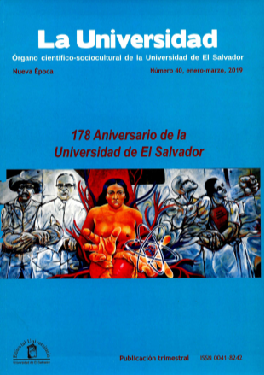Monseñor Romero como inspirador del arte popular
Keywords:
Magnicide, ascent to the altars, stages, creativity, popular artAbstract
The assassination commítted in the person of Monsignor áscar Arnulfo Romero y Galdámez (1917-1980) permeated consciences in the different cardinal points and gradually led to widespread condemnatíon, as well as recognition of bis sacrifice as a religious pastor, at least through two powerful ways that in those calendas of the XX century nobody imagined, perhaps only he with his prophetic words: "lf they kill me, I wat resuscítate in the Salvadoran people". One of those routes is the one that would lead him to the altars of the Catholic Church and, the other, the one that would install him on the altars of popular art on an international scale. Thus, and regardless of classify or not such expressions as religious art, their image and testimony of life are present in many countries, cities and most remote villages of the world and, of course, their native country: El Salvador. This modest article revíews how the figure of Monsignor Romero ís present in practically all manífestations of human creativíty: artístíc posters, murals and easel paintíngs, sculpture, music, singing, dance, theater, poetry, cinema, among others. Less important. But also, beyond the galleries, government offices, schools, parks and streets, etc., the Martyr is present in expressions and forms more accessible to the people for whom he offered his life, as in the artísan production: T-shirts and Other clothes in serigraphy, miniatures in clay, key rings ... It became the most universal Salvadoran personality.
Downloads
References
Biblioteca virtual universal, Día a día con monseñor Romero, 2003.
Delgado Acevedo, Jesús. Ciscar A. Romero, Biografía, Ediciones Paulinas, 1986.
Revista de Filología y Lingüística, Volumen XIII, Universidad de Costa Rica, 1986.
Downloads
Published
How to Cite
Issue
Section
License
Copyright (c) 2021 Jorge Vargas Méndez

This work is licensed under a Creative Commons Attribution-NonCommercial 4.0 International License.
Los textos académicos y científicos que se publican en la Revista La Universidad están protegidos bajo la licencia CC BY NC SA 4.0, esta permite usar una obra para crear otra obra o contenido, modificando o no la obra original, siempre que se cite al autor, la obra resultante se comparta bajo el mismo tipo de licencia y no tenga fines comerciales (https://creativecommons.org/licenses/by-nc-sa/4.0/deed.es) . El autor es el único que pose los derechos de publicación y la Revista La Universidad posee los derechos de difusión.





